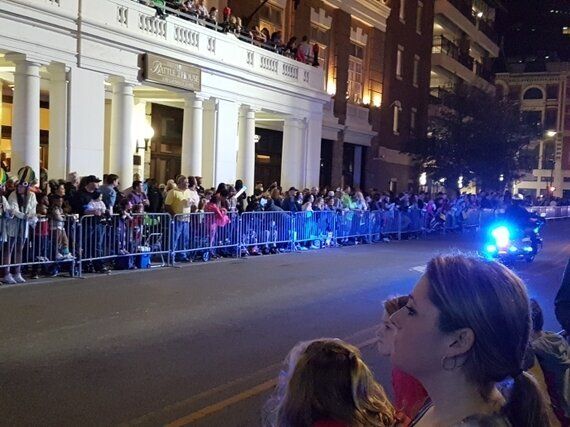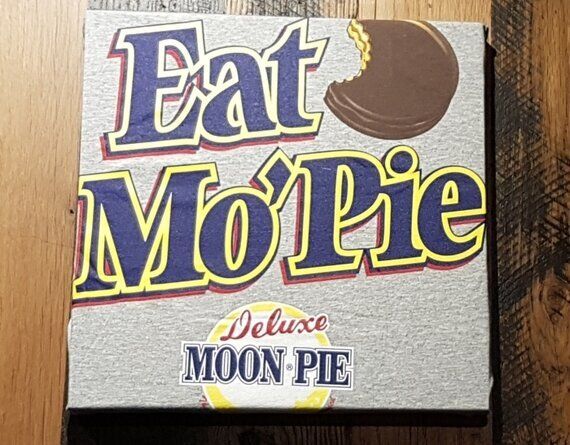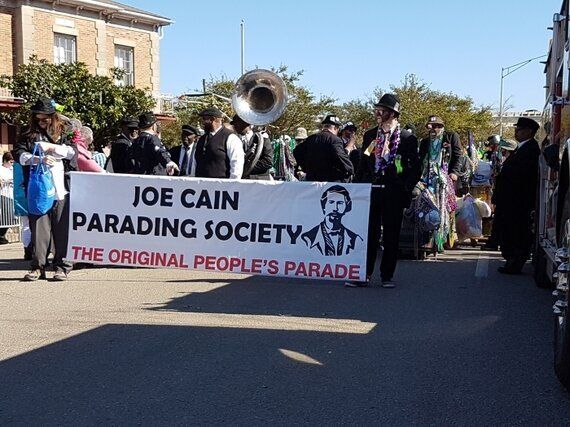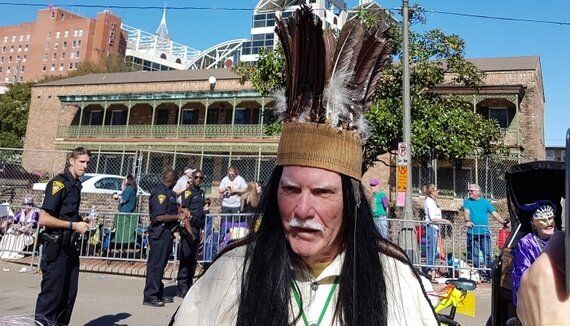
'Let's rock 'n' roll!', the policewoman yelled to the crowd. Not a phrase you expect to hear from a policewoman but this one was in Mobile, Alabama, and getting people fired up for a Mardi Gras parade. The cops, some wearing beads or flowers, were roaring their bikes up and down, making sure the streets were clear, the vendors and their carts were out of the way, and the crowds all safely behind barriers.

Getting Ready to Rock 'n' Roll
From where I was standing, opposite the Battle House Hotel on the corner of Royal and Francis, the crowd knew that the parade had started over near the Civic Center and was on its way. They knew because above our heads from the top of a building a 600lb electronic moon pie had started to descend slowly down. For the uninitiated, a moon pie is marshmallow encased in biscuit and wrapped in chocolate. They originated in Chattanooga, and are especially popular in the south. It's become a tradition to throw them from Mardi Gras floats along with beads, miniature footballs and just about anything else that can be thrown.

In Mobile someone had the bright idea of making a 12-foot moon pie that would drop down the side of a building to celebrate New Year, in the way the Times Square Ball drops in New York. You have to admire someone who comes up with an idea like that, wonderful for its sheer daftness. It was only later it was decided to use the giant moon pie to signal to the downtown crowds that a Mardi Gras parade had started.
Mobile is where Mardi Gras originated in the United States, first celebrated in 1703 by French settlers who brought the tradition from Europe. Mardi Gras in New Orleans may be better-known - notorious, even - but Mobile beat them to it by several years. It's also much more of a family occasion than the raucous behaviour you get in New Orleans.

'I went to New Orleans a few years ago,' a woman standing next to me in the crowd said. 'I just wanted to see what it was like. It wasn't nothing like Mobile. The crowds were so big you were packed shoulder-to-shoulder and couldn't move around, and they did things in New Orleans that would get you arrested if you tried them in Mobile.'
It's not that they don't know how to party in Alabama's third-biggest city. From early morning onwards the bars are busy, with live bands playing. And they say there are three seasons in Alabama: football season, hurricane season and Mardi Gras season. Mardi Gras can start as early as November, and there are parades and Mardi Gras balls held for several weeks before the week building up to Mardi Gras itself (13th February in 2018).
One of the best days to be in Mobile is on the Sunday before Fat Tuesday, when the Joe Cain People's Parade takes place. Anyone can apply to march in this parade, unlike the other parades where you have to be a member or guest of the organisation putting it on.

The People's Parade honours Joe Cain, the man credited with bringing Mardi Gras back to Mobile after the celebrations were interrupted by the Civil War. Cain was born in Mobile in 1832, and was a member of the Fire Department. In 1867 he went to the Mardi Gras celebrations in New Orleans, which had already been reinstated, as a guest of one of that city's Fire Departments.
The following year, with Mobile still occupied by Union troops, Joe Cain, a Confederate veteran, decided it was time to have some fun in his home city too. The legend (and it is only legend) is that on Fat Tuesday Cain dressed himself up as a fictional Chickasaw chief who he called Chief Slacabamorinico. This was intended as an insult to the Union Army, which may have defeated the South but had never defeated the Chickasaw tribe. He was joined by some friends who banged drums and played various other musical instruments and rode in an old coal wagon. They became known as the Lost Cause Minstrels and the music was so bad that they were soon followed by groups of kids and adults, all joining in the fun. (Whether this actually happened you can read about at www.themobilemask.com/Joe_Cain.html).

Wayne Dean as Chief Slacabamorinico
Whatever the truth, Joe Cain is acknowledged as the man who brought Mardi Gras back to the streets of Mobile, and Sunday is Joe Cain Day. His People's Parade is led by Chief Slacabamorinico himself, which is currently Wayne Dean, a retired Methodist pastor who has played the role of the chief for 32 years. With a police escort and his Lost Cause Minstrels, Joe Cain climbs onto a wagon and leads a motley band of people through the streets of Mobile, all throwing beads and moon pies to the eager crowds. Kids beg for beads, people yell from balconies, families have set up picnic tables in parks and behind the barriers, watching the parade from the comfort of deckchairs with a beer in their hand. There's not a hint of New Orleans depravities, but it's a huge amount of fun. Let's rock 'n' roll indeed.

More Information
To find out about joining in the Joe Cain People's Parade, visit the Joe Cain Parading Society on Facebook: www.facebook.com/JoeCainParadingSociety.
Photos
All photos (c) Mike Gerrard.